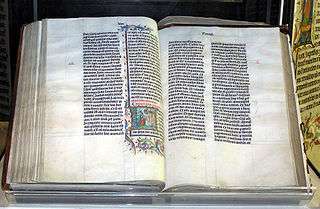Biblical languages
Biblical languages are any of the languages employed in the original writings of the Bible. Partially owing to the significance of the Bible in society, Biblical languages are studied more widely than many other dead languages. Furthermore, some debates exist as to which language is the original language of a particular passage, and about whether a term has been properly translated from an ancient language into modern editions of the Bible. Scholars generally recognize three languages as original biblical languages: Hebrew, Aramaic, and Koine Greek.
| Part of a series on the |
| Bible |
|---|
 |
|
Perspectives |
|
Outline of Bible-related topics |
Language of the Hebrew Bible
The Hebrew Bible, also known as the Tanakh (Hebrew: תנ"ך), consists of 39 books. "Hebrew" in "Hebrew Bible" may refer to either the Hebrew language or to the Hebrew people who historically used Hebrew as a spoken language, and have continuously used the language in prayer and study, or both. The texts were mainly written in Biblical Hebrew, with some portions (notably in Daniel and Ezra) in Biblical Aramaic. Biblical Hebrew, sometimes called Classical Hebrew, is an archaic form of the Hebrew language.
The very first translation of the Hebrew Bible was into Greek. This is known as the Septuagint (LXX), which later became the received text of the Old Testament in the Catholic church and the basis of its canon. This began sometime in the 2nd or 3rd century BC, with the first portion of the Hebrew Bible, the Torah, being translated into Koine Greek. Over the next century, other books were translated (or composed) as well. This translation became known as the Septuagint and was widely used by Greek-speaking Jews, and later by Christians. It differs somewhat from the later standardized Hebrew (Masoretic Text). This translation was promoted by way of a legend that seventy separate translators all produced identical texts.
The Latin Vulgate by Jerome was based upon the Hebrew for those books of the Bible preserved in the Jewish canon (as reflected in the Masoretic Text), and on the Greek text for the rest. Other ancient Jewish translations, such as the Aramaic Targums, conform closely to the Masoretic Text, and all medieval and modern Jewish translations are based upon the same. Christian translations also tend to be based upon the Hebrew, though some denominations prefer the Septuagint (or may cite variant readings from both). Bible translations incorporating modern textual criticism usually begin with the Masoretic Text, but also take into account possible variants from all available ancient versions.
Languages of the New Testament
The books of the Christian New Testament are widely agreed to have originally been written in Greek, specifically Koine Greek, even though some authors often included translations from Hebrew and Aramaic texts. Certainly the Pauline Epistles were written in Greek for Greek-speaking audiences. See Greek primacy for further details. Koine Greek was the popular form of Greek which emerged in post-classical antiquity (c.300 BC – AD 300), and marks the third period in the history of the Greek language.[1] It is also called Alexandrian, Hellenistic, Common, or New Testament Greek.
Some scholars believe that some books of the Greek New Testament (in particular, the Gospel of Matthew) are actually translations of a Hebrew or Aramaic original. A famous example of this is the opening to the Gospel of John, which some scholars argue to be a Greek translation of an Aramaic hymn. Of these, a small number accept the Syriac Peshitta as representative of the original. See Aramaic primacy.
Likewise, some traditional Roman Catholic scholars believed the Gospel of Mark was originally written in Latin.
However, the received text of the New Testament is Greek and nearly all translations are based upon the Greek text.
References
- Andriotis, Nikolaos P. History of the Greek language